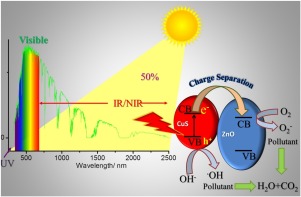Applied Catalysis A: General ( IF 4.7 ) Pub Date : 2019-06-28 , DOI: 10.1016/j.apcata.2019.117124 Tuhin Kumar Maji , Probir Kumar Sarkar , Prasenjit Kar , Bo Liu , Peter Lemmens , Debjani Karmakar , Samir Kumar Pal

|
Complete utilization of solar light in the photocatalytic reaction is of paramount importance for efficient conversion of solar light. Although NIR constitutes almost 50% of the solar energy, there are very few efforts towards its effective utilization in photocatalysis. The difficulty of NIR usage is its associated low energetic photons, which can lead to exciton generation only for low band-gap semiconducting systems, which is sometime not enough to initiate photocatalytic process. Moreover, these type of systems have very fast charge recombination process. Assembling one low band gap semiconductor with a wide bandgap semiconductor to form a nanohybrid heterojunction could be an efficient NIR harvesting photocatalyst. Herein, we report a novel CuS-ZnO nanohybrid, bound by a cysteine ligand, to exhibit efficient photocatalytic performance using the NIR fraction of the solar light spectrum. Raman spectroscopy and picosecond resolved studies have been carried out to confirm the electronic coupling of the nanohybrid. An improved photocatalytic activity towards degradation of methyl orange (MO) was observed by the nanohybrid compared to its individual counterparts (ZnO and CuS) under NIR light illumination. First principles investigations have guided us in obtaining an insight to the photocatalytic process. Computationally predicted band alignment implies that the nanohybrid forms a type II heterojunction. An increment of significant charge separation from the conduction band of CuS to those of ZnO is the key mechanism behind the enhanced photocatalysis.
中文翻译:

纳米杂化材料在NIR光催化中的潜在应用的组合实验和计算研究
在光催化反应中完全利用太阳光对于有效转换太阳光至关重要。尽管NIR几乎占太阳能的50%,但在将其有效地用于光催化方面的工作很少。使用NIR的困难在于其相关的低能光子,仅对于低带隙半导体系统,这可能导致激子生成,这有时不足以引发光催化过程。而且,这些类型的系统具有非常快速的电荷重组过程。将一种低带隙半导体与宽带隙半导体组装在一起以形成纳米杂化异质结可能是一种有效的近红外捕获光催化剂。在此,我们报告了一种新型的由半胱氨酸配体结合的CuS-ZnO纳米杂化物,使用太阳光谱的NIR分数显示出有效的光催化性能。拉曼光谱和皮秒分辨的研究已经进行,以确认纳米杂化物的电子耦合。在近红外光照射下,纳米杂化物与其相应的对应物(ZnO和CuS)相比,观察到了对甲基橙(MO)降解的改善的光催化活性。第一性原理研究已指导我们获得对光催化过程的深入了解。通过计算预测的能带对齐方式表明,纳米杂化物形成了II型异质结。从CuS的导带到ZnO的导带的显着电荷分离的增加是增强光催化作用的关键机制。拉曼光谱和皮秒分辨的研究已经进行,以确认纳米杂化物的电子耦合。在近红外光照射下,纳米杂化物与单独的对应物(ZnO和CuS)相比,观察到了对甲基橙(MO)降解的改善的光催化活性。第一性原理研究已指导我们获得对光催化过程的深入了解。通过计算预测的能带对齐方式表明,纳米杂化物形成了II型异质结。从CuS的导带到ZnO的导带的显着电荷分离的增加是增强光催化作用的关键机制。拉曼光谱和皮秒分辨的研究已经进行,以确认纳米杂化物的电子耦合。在近红外光照射下,纳米杂化物与其相应的对应物(ZnO和CuS)相比,观察到了对甲基橙(MO)降解的改善的光催化活性。第一性原理研究已指导我们获得对光催化过程的深入了解。通过计算预测的能带对齐方式表明,纳米杂化物形成了II型异质结。从CuS的导带到ZnO的导带的显着电荷分离的增加是增强光催化作用的关键机制。在近红外光照射下,纳米杂化物与单独的对应物(ZnO和CuS)相比,观察到了对甲基橙(MO)降解的改善的光催化活性。第一性原理研究已指导我们获得对光催化过程的深入了解。通过计算预测的能带对齐方式表明,纳米杂化物形成了II型异质结。从CuS的导带到ZnO的导带的显着电荷分离的增加是增强光催化作用的关键机制。在近红外光照射下,纳米杂化物与其相应的对应物(ZnO和CuS)相比,观察到了对甲基橙(MO)降解的改善的光催化活性。第一性原理研究已指导我们获得对光催化过程的深入了解。通过计算预测的能带对齐方式表明,纳米杂化物形成了II型异质结。从CuS的导带到ZnO的导带的显着电荷分离的增加是增强光催化作用的关键机制。
















































 京公网安备 11010802027423号
京公网安备 11010802027423号